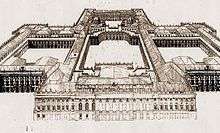Project of Filippo Juvarra for the Royal Palace of Madrid

The Project of Filippo Juvarra for the Royal Palace of Madrid was the ambitious and first project for the Royal Palace of Madrid.
Background and context
The Royal Alcázar of Madrid. An alcázar closely linked to the Habsburgs, and was the residence of the Spanish Royal Family. In 1700 Charles II died childless, the last of Hapsburg kings, and finally is Philip V of the Bourbon dynasty, who continue to reign in Spain.
Philip V was born in Versailles (France), and his tastes are different from those of the former Habsburg dynasty. It is known that to get to Madrid not found the city he wanted, and that the Alcázar he seemed as gloomy as austere. This monarch was not used to these buildings, and the antipathy toward this place was more pronounced because it represented the symbol of the power of the previous dynasty, the Habsburgs.
On Christmas Eve 1734 Madrid's history changed. It was possibly in the chambers of painter of the court French Jean Ranc where the fire started to destroy the Royal Alcázar of Madrid completely. The bells of midnight of the neighboring Convento de San Gil (where today the Café de Oriente is located), who tried to warn of fire, led to believe the locals that it was calling to mass (since being Christmas Eve, it was common to go to Midnight Mass). Canvases as "Las Meninas" by Velazquez could be saved being thrown through the windows of the alcázar, but it is believed that more than 500 paintings were lost by the fire.
After the mysterious fire, Philip V had the opportunity to build a new palace which would be an emblem of the power of the Bourbon Dynasty and to show the luxury and splendor to which he was so accustomed.
Original project

Filippo Juvarra, known Italian architect who had spent most of his work in Turin was chosen to raise this new Royal Palace. Shortly after the fire, in April 1734, Juvarra moved to Madrid, and soon has prepared his project for the new residence of the Spanish royal family: A palace complex, with various squares and gardens, would make of this building between the most ambitious in the history of the city of Madrid. This would be a baroque building with four large courtyards, following the usual form in Italy. And it was intended that the building had traces both Italian and French. One whole side of the main courtyard would be dominated by the main staircases, and between the two most important courtyards would be located the library and the chapel.
The first to catch attention was the big dimensions of the palace. Of having been built on the place where was located the Royal Alcázar, one of the squares of the palace would be located on the Calle Mayor, and the gardens throughout all the area of Principe Pío. That is why this residence not would be located in this historic place. It should find a flat area in which to develop this ambitious project, and where the flower gardens could be admired at its best. The exact area where the palace would have been located was never known, although places like the current barrio de Argüelles was being considered.
Juvarra designed a wooden model that served to illustrate his major project.
Another feature of the new monument would be its construction materials: it would not use wood so that the new palace would not be devoured by flames again, so would be built entirely of stone and brick.
The truth is that the project of Juvarra was not one more. It was meant to be the highlight project of the Bourbon dynasty, which showed that Spain left behind a time for one even more monumental.[1]
Current building
In 1737 the architect Giovanni Battista Sacchetti arrives at Madrid, a former disciple of Filippo Juvarra in Turin. He was used in that city to carry out the designs created by his teacher. However, upon arrival in Madrid he is made to a different order; he had to adapt the grand palace designed by his mentor to the place where the old alcázar was located. Juvarra himself had said that in the case of an uneven and narrow terrain, he would be dwarfed his work there.
In that same 1737 Sacchetti has prepared his project, and in 1738 start the construction, which would not end until 1764, under the reign of Charles III, being completed by Francesco Sabatini and participation of renowned Spanish architects like Ventura Rodríguez.
It is possible that Juvarra's prestige helped convince Philip V to build the new palace in a different place and in proportions that would have made this building one of the most magnificent of 18th century Europe. However, today we can only imagine this monument thanks to the architect's plans.
The existing Royal Palace is however one of the most characteristic and imposing royal palaces of Europe.
